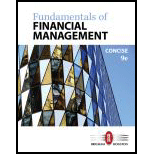
Fundamentals of Financial Management, Concise Edition (MindTap Course List)
9th Edition
ISBN: 9781305635937
Author: Eugene F. Brigham, Joel F. Houston
Publisher: Cengage Learning
expand_more
expand_more
format_list_bulleted
Concept explainers
Question
Chapter 5, Problem 39P
Summary Introduction
To calculate: Amount Person X should save in next 10 years to meet his retirement goal
Introduction:
It is an agreement under which person pays the lump sum payment or the number of small transactions. In return, the person gets the amount at later date or upon annuitization. The purpose of the annuity is to not break the flow of income after retirement.
Expert Solution & Answer
Trending nowThis is a popular solution!

Students have asked these similar questions
I need help completing a chart with the following base on Amazon
What is the primary purpose of financial management?
A) Maximizing profits
B) Minimizing costs
C) Maximizing shareholder wealth
D) Managing liquidity need help!
What is the primary purpose of financial management?
A) Maximizing profits
B) Minimizing costs
C) Maximizing shareholder wealth
D) Managing liquidity
Chapter 5 Solutions
Fundamentals of Financial Management, Concise Edition (MindTap Course List)
Ch. 5 - Prob. 1QCh. 5 - Explain whether the following statement is true or...Ch. 5 - If a firms earnings per share grew from 1 to 2...Ch. 5 - Would you rather have a savings account that pays...Ch. 5 - Prob. 5QCh. 5 - Prob. 6QCh. 5 - Banks and other lenders are required to disclose a...Ch. 5 - Prob. 8QCh. 5 - Prob. 1PCh. 5 - PRESENT VALUE What is the present value of a...
Ch. 5 - FINDING THE REQUIRED INTEREST RATE Your parents...Ch. 5 - Prob. 4PCh. 5 - TIME TO REACH A FINANCIAL GOAL You have 33,556.25...Ch. 5 - Prob. 6PCh. 5 - PRESENT AND FUTURE VALUES OF A CASH FLOW STREAM An...Ch. 5 - LOAN AMORTIZATION AND EAR You want to buy a car,...Ch. 5 - Prob. 9PCh. 5 - PRESENT AND FUTURE VALUES FOR DIFFERENT INTEREST...Ch. 5 - GROWTH RATES Sawyer Corporations 2015 sales were 5...Ch. 5 - EFFECTIVE RATE OF INTEREST Find the interest rates...Ch. 5 - Prob. 13PCh. 5 - Prob. 14PCh. 5 - PRESENT VALUE OF AN ANNUITY Find the present...Ch. 5 - Prob. 16PCh. 5 - EFFECTIVE INTEREST RATE You borrow 230,000; the...Ch. 5 - Prob. 18PCh. 5 - FUTURE VALUE OF AN ANNUITY Your client is 26 years...Ch. 5 - Prob. 20PCh. 5 - EVALUATING LUMP SUMS AND ANNUITIES Kristina just...Ch. 5 - LOAN AMORTIZATION Jan sold her house on December...Ch. 5 - Prob. 23PCh. 5 - Prob. 24PCh. 5 - Prob. 25PCh. 5 - PV AND LOAN ELIGIBILITY You have saved 4,000 for a...Ch. 5 - EFFECTIVE VERSUS NOMINAL INTEREST RATES Bank A...Ch. 5 - NOMINAL INTEREST RATE AND EXTENDING CREDIT As a...Ch. 5 - BUILDING CREDIT COST INTO PRICES Your firm sells...Ch. 5 - Prob. 30PCh. 5 - REQUIRED LUMP SUM PAYMENT Starting next year, you...Ch. 5 - REACHING A FINANCIAL GOAL Six years from today you...Ch. 5 - FV OF UNEVEN CASH FLOW You want to buy a house...Ch. 5 - AMORTIZATION SCHEDULE a. Set up an amortization...Ch. 5 - AMORTIZATION SCHEDULE WITH A BALLOON PAYMENT You...Ch. 5 - Prob. 36PCh. 5 - Prob. 37PCh. 5 - Prob. 38PCh. 5 - Prob. 39PCh. 5 - REQUIRED ANNUITY PAYMENTS A father is now planning...Ch. 5 - Prob. 41SPCh. 5 - Prob. 42IC
Knowledge Booster
Learn more about
Need a deep-dive on the concept behind this application? Look no further. Learn more about this topic, finance and related others by exploring similar questions and additional content below.Similar questions
- The time value of money concept assumes that: A) A dollar today is worth more than a dollar tomorrow B) A dollar tomorrow is worth more than a dollar today C) Money has no time value D) Money grows at a fixed interest rate need answer.arrow_forwardThe time value of money concept assumes that: A) A dollar today is worth more than a dollar tomorrow B) A dollar tomorrow is worth more than a dollar today C) Money has no time value D) Money grows at a fixed interest ratearrow_forwardWhich option is correct? 19. In financial terms, liquidity refers to: A. Profitability of an investmentB. Ability to meet short-term obligationsC. Long-term solvencyD. Market value of equityarrow_forward
- The following data provides the monthly Comcast cable bill for a random sample of 20 households along with the number of televisions in the household (TV), the number of people living in the household (People), and the number of years that household has been a Comcast customer (Years). Bill TV People Years $56 1 3 8 $59 3 5 11 $67 3 2 3 $75 2 3 8 $76 4 1 8 $82 1 5 4 $84 3 3 3 $84 1 3 8 $84 4 4 4 $90 2 4 3 $91 3 5 5 $100 2 7 9 $100 2 2 5 $102 4 4 6 $104 3 5 10 $104 3 4 6 $112 4 3 2 $114 4 5 8 $130 5 5 1 $135 5 6 7 Develop a regression equation that will predict the monthly Comcast cable bill for a household based on the number of televisions in the household, the number of people living in the household, and the number of years that household has been a Comcast…arrow_forwardcan you provide correct answer for this question? If the Net Present Value (NPV) of a project is positive, it indicates: A. The project is unprofitableB. The project is financially viableC. The project has no riskD. The project will increase costsarrow_forwardI need correct answer for this question! If the Net Present Value (NPV) of a project is positive, it indicates: A. The project is unprofitableB. The project is financially viableC. The project has no riskD. The project will increase costsarrow_forward
- The market where new securities are issued and sold to investors is called: A. Secondary marketB. Money marketC. Primary marketD. Over-the-counter marketarrow_forwardA bond is trading at a premium when: A. Its coupon rate is equal to the yield to maturityB. Its market price is higher than its face valueC. Its market price is lower than its face valueD. It is issued by a well-rated companyarrow_forwardNeed help ! In financial terms, liquidity refers to: A. Profitability of an investmentB. Ability to meet short-term obligationsC. Long-term solvencyD. Market value of equity need answerarrow_forward
- In financial terms, liquidity refers to: A. Profitability of an investmentB. Ability to meet short-term obligationsC. Long-term solvencyD. Market value of equityarrow_forwardNeed help! Which type of risk cannot be eliminated through diversification? A. Market riskB. Credit riskC. Operational riskD. Unsystematic riskarrow_forwardWhich type of risk cannot be eliminated through diversification? A. Market riskB. Credit riskC. Operational riskD. Unsystematic riskarrow_forward
arrow_back_ios
SEE MORE QUESTIONS
arrow_forward_ios
Recommended textbooks for you
 EBK CONTEMPORARY FINANCIAL MANAGEMENTFinanceISBN:9781337514835Author:MOYERPublisher:CENGAGE LEARNING - CONSIGNMENT
EBK CONTEMPORARY FINANCIAL MANAGEMENTFinanceISBN:9781337514835Author:MOYERPublisher:CENGAGE LEARNING - CONSIGNMENT Excel Applications for Accounting PrinciplesAccountingISBN:9781111581565Author:Gaylord N. SmithPublisher:Cengage Learning
Excel Applications for Accounting PrinciplesAccountingISBN:9781111581565Author:Gaylord N. SmithPublisher:Cengage Learning PFIN (with PFIN Online, 1 term (6 months) Printed...FinanceISBN:9781337117005Author:Randall Billingsley, Lawrence J. Gitman, Michael D. JoehnkPublisher:Cengage Learning
PFIN (with PFIN Online, 1 term (6 months) Printed...FinanceISBN:9781337117005Author:Randall Billingsley, Lawrence J. Gitman, Michael D. JoehnkPublisher:Cengage Learning

EBK CONTEMPORARY FINANCIAL MANAGEMENT
Finance
ISBN:9781337514835
Author:MOYER
Publisher:CENGAGE LEARNING - CONSIGNMENT


Excel Applications for Accounting Principles
Accounting
ISBN:9781111581565
Author:Gaylord N. Smith
Publisher:Cengage Learning

PFIN (with PFIN Online, 1 term (6 months) Printed...
Finance
ISBN:9781337117005
Author:Randall Billingsley, Lawrence J. Gitman, Michael D. Joehnk
Publisher:Cengage Learning